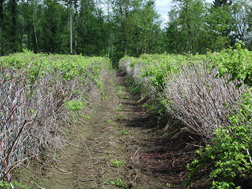Halting Black Raspberry Decline
|
|
Loaded with ellagic acid, vitamin C, and antioxidants, black raspberries are a nutritious addition to fruit salads, sauces, and desserts. Their purple-black hue indicates a high concentration of anthocyanins, which have been linked to cancer prevention in humans.
If only these nutrients had the same beneficial effect on plant health. In Oregon, the nation’s main black raspberry producer, symptoms of the disease known as “black raspberry decline” have surfaced in every region of the state where the berries are grown.
Symptoms include yellowing leaves due to a chlorophyll deficiency, puckered and spotted leaves, yield reduction, and cane dieback—gradual death of shoots, branches, and roots, from the tip inward.
The disease shortens a plant’s life expectancy from several decades to 3-4 years, with severe economic repercussions. Replanting can cost farmers about $2,000 an acre in addition to profit losses resulting from reduced yields.
In an important step toward controlling the disease, ARS plant pathologist Robert Martin has identified one cause of it: the black raspberry decline-associated virus (BRDaV).
“Decline is generally a symptom of a virus complex,” says Martin, research leader in the ARS Horticultural Crops Research Unit at Corvallis, Oregon. “In most cases, a plant infected with one virus will not show such severe symptoms. But plants infected only with BRDaV do.”
Martin discovered the new virus with ARS colleagues and Oregon State University graduate student Anne Halgren. They found BRDaV by extracting double-stranded RNA from affected plants, which indicates virus infection. This was then cloned, and a routine laboratory procedure called RT-PCR (reverse transcription-polymerase chain reaction) was developed for detecting the virus. RT-PCR is a standard method for making many copies of small pieces of DNA so they can be more easily studied or detected.
This technique allows scientists to efficiently gather information on new viruses, even from asymptomatic plants.
Martin and his colleagues have already used this method to obtain sequence information on 17 berry viruses, including BRDaV.
In a related discovery, the team has learned that BRDaV hitches a ride on the raspberry aphid Amphorophora agathonica. In fact, disease spread rates appear to be directly related to aphid numbers. This suggests that controlling the aphid population could slow the disease’s spread.
Because BRDaV can trigger decline without the presence of other viruses, it’s a much more potent threat to the berry industry. The Corvallis scientists are studying which management tactics will control it most effectively.
They have also learned that BRDaV can infect other commercial and native raspberry and blackberry plants without triggering symptoms. Thus, isolation of black raspberry fields from plantings of these other berries will be an important part of a disease-control strategy. The researchers are currently conducting field studies to understand the virus’s epidemiology.
“Presently, little information exists on the viruses that cause many diseases of small fruit crops,” says Martin. “Understanding which ones are involved and how they are transmitted is the first step in developing a control strategy.”—By Laura McGinnis, Agricultural Research Service Information Staff.
This research is part of Plant Diseases, an ARS National Program (#303) described on the World Wide Web at www.nps.ars.usda.gov.
Robert Martin is in the USDA-ARS Horticultural Crops Research Unit, 3420 N.W. Orchard Ave., Corvallis, OR 97330; phone (541) 738-4041, fax (541) 738-4025.
"Halting Black Raspberry Decline" was published in the June 2006 issue of Agricultural Research magazine.







